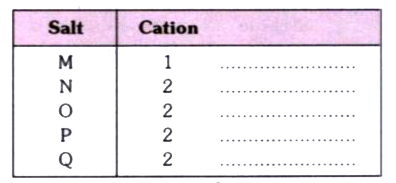Potassium chloride is added to water and stirred. A salt solution is obtained which is then boiled leaving behind a residue.
Give a reason why the above experimentation would not be possible, if calcium carbonate is taken, in place of potassium chloride.
Step by step video & image solution for Potassium chloride is added to water and stirred. A salt solution is obtained which is then boiled leaving behind a residue. Give a reason why the above experimentation would not be possible, if calcium carbonate is taken, in place of potassium chloride. by Chemistry experts to help you in doubts & scoring excellent marks in Class 8 exams.
Topper's Solved these Questions
- BOOK - ICSECHAPTER - PHYSICAL & CHEMICAL CHANGESEXERCISE - OBJECTIVE TYPE QUESTIONS (Physical & Chemical Changes)21videos
PHYSICAL & CHEMICAL CHANGES
- BOOK - ICSECHAPTER - MATTEREXERCISE - EXERCISE (J. Short answer questions)5videos
MATTER
- BOOK - ICSECHAPTER - PHYSICAL AND CHEMICAL CHANGES EXERCISE - Think and answer4videos
PHYSICAL AND CHEMICAL CHANGES
Similar Questions
Potassium chloride is added to water and stirred. A salt solution is obtained which is then boiled leaving behind a residue.
Is the change reversible or not reversibleView SolutionPotassium chloride is added to water and stirred. A salt solution is obtained which is then boiled leaving behind a residue.
Is the above change physical or chemicalView SolutionPotassium chloride is added to water and stirred. A salt solution is obtained which is then boiled leaving behind a residue.
Name the residue which remains behind after the salt solution is boiledView SolutionPotassium chloride is added to water and stirred. A salt solution is obtained which is then boiled leaving behind a residue.
Are the composition and properties of the original substance alteredView SolutionA solution of potassium chloride has no effect on litmus whereas, a solution of zinc chloride turns the blue litmus red. Give a reason.
View Solution12 g of a saturated solution of potassium chloride at 20∘C, when evaporated to dryness, leaves a solid residue of 3 g. Calculate the solubility of potassium chloride.
View SolutionA compound (X) with the molecular formula C6H10O4 is a neutral liquid. On heating (X), under reflux with aqueous sodium hydroxide and distilling the product. A colourless liquid is obtained which on warming with iodine and aqueous sodium hydroxide gives a pale yellow precipatate (Y). The residue in the distilling flask is the sodium salt of an acid (Z), which decolourises aqueous acidified potassium permaganate (VII) on heating. Identify (X),(Y), and (Z) and give all the reactions involved.
View SolutionSalts M, N, O, P and Q undergo reactiom (i) to (v) respectively.
Identify the cation present in these salts on the basis of these reaction. Tabulate your answer in the format given below.
1. When sodium hydroxide solution is added to the salt M, and heated strongly a colourless gas with a pungent smell is evolved which turm red litmus paper blue and gives dense white fumes with a moist glass rod with hydrochloric acid.
2. Addition of dilute hydrochloric acid to a solution of N gives a thick white precipitate which is soluble in hot water.
3. When ammonium hydroxide solution is added to the solution of 0 a light blue precipitate is obtained which is soluble in excess of ammonium hydroxide to form an inteme deep blue solution.
4. When ammonium hydroxide solution is added to the solution of P reddish brown (mustard colour) precipitate is obtained which ,is insoluble even in the excess of ammonium hydroxide solution.
5. When sodium hydroxide solution is added to the solution of Q a which coloured gelatinous precipitate is obtained which is soluble in excess of sodium hydroxide to form a clear solution
 View Solution
View SolutionElectrolysis of aqueous solutions of which of the following substances results in only the decomposition of water ?
1) Potassium chloride
2) Zinc sulphate
3) Potassium hydroxide
4) Sodium phosphateView SolutionConsider the following statement:
S1:Cu2+ ions are reduced to Cu+ by potassium iodide and potassium cyanide both, when taken in excess
S2:H2S will precipitate the sulphide of all the metals from the solutions of chlorides of Cu,Zn and Cd if the solution is aqueous.
S3:The presence of magnesium is confirmed in qualitative analysis by the formation of a white crystal
S4 :Calomel on reaction with potassium iodide gives red precipitate.
and arrange in the order of true/false.View Solution

